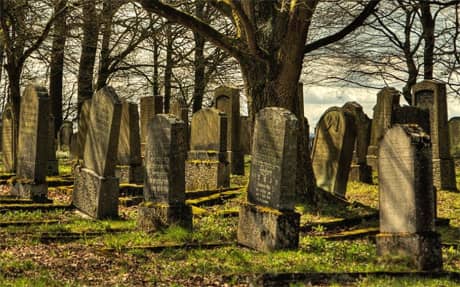

In larger urban areas things eventually got out of control with large crowds on the grounds and the litter that they left behind. Many other countries traditionally have meals in the cemetery, but it was a new practice in the United States. Having a picnic among the dead then became fashionable in these beautiful green spaces, giving families the chance to include their deceased loved ones. Death at that time was viewed more as a gentle sleep, and visitation was an accepted way to keep the person close to the family. In the 19th century, epidemics took many children at an early age, and women died in childbirth making death far too common in families. The elaborate entrance gates were a way to separate the living world from the dead people were entering a place of tranquility, meditation and spiritual communing. The pleasant designs of the headstones, beautiful statues and the park like landscaping enticed people into the tranquil setting. The cemeteries were the closest thing to a park that many people had access to, especially in the city. In the 1830’s when the rural cemetery movement was evolving, having a picnic in the local cemetery became a popular thing to do. Rural cemeteries were modeled after the Pere-Lachaise Cemetery in Paris, and the first rural or garden cemetery located in the United States was Mount Auburn in Cambridge, Massachusetts in 1831.

In some cases, after a designated time has elapsed, headstones are removed and the land is repurposed for a park or other use. Attitudes toward the destruction of cemeteries or graves varies from country to country from those that consider it normal to destroy them, to those who feel they should be respected for more than a century. In order to solve the many problems, burial grounds outside of the city/town limits run by the municipality became the norm.

In 18th century France approximately 6 million skeletons were located to the Catacombs of Paris. In some areas, skeletons were exhumed and moved to catacombs or ossuaries to allow for more burials. A flood was often disastrous, washing out layers of coffins and bodies into the surrounding neighborhood. In the early 1800’s Europe had a dramatic increase in population, and many churchyard burials were gradually outlawed due to the overcrowding and recurring infectious diseases near the cemeteries. Those who could not afford a headstone placed a metal or wooden cross at the burial site. Those who could afford a headstone were usually wealthier, and the more extensive the inscription or artistic value the more wealth was demonstrated. Indigents, unknown travelers, undesirables and stillborn babies among others, were buried on the North side.

The next best real estate was on the South side of the church. Those of higher influence were buried on the East side of the church to face the rising sun as they went to the hear-after.
#Cemetery vs graveyard full#
People of importance were often buried within the church itself with full stone inscriptions, and the next level of importance landed in the churchyard where there was also a hierarchy. Initially burials were in mass graves until they decomposed, and then the bones were removed to ossuaries along the walls of the cemetery or under the floor within the church. In Europe, burial was under the strict control of the church. The burial of a body or cremains infers interment in a grave or a tomb, above ground grave, mausoleum, columbarium, or niche. A graveyard is a term that can be used interchangeably, but refers specifically to a churchyard burial ground. The term was originally applied to the Roman catacombs. The word “cemetery” has its origins in the Greek word for “sleeping place”, and is land meant for burial.


 0 kommentar(er)
0 kommentar(er)
